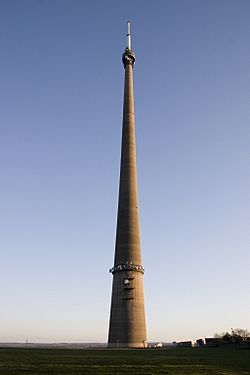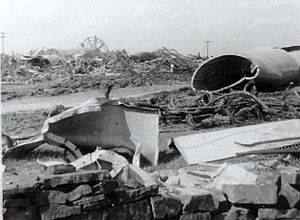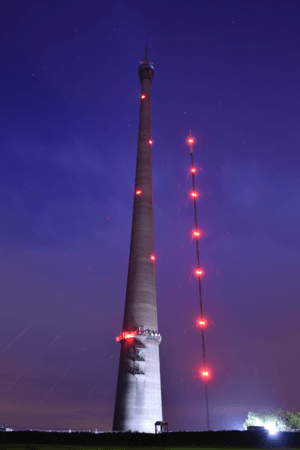Emley Moor transmitting station facts for kids
 |
|
| Tower height | 330.4 m (1,084 ft) |
|---|---|
| Coordinates | 53°36′43″N 1°39′52″W / 53.611944°N 1.664444°W |
| Grid reference | SE222128 |
| Built | 1969 - 1971 |
| BBC region | BBC Yorkshire |
| ITV region | ITV Yorkshire |
| Local TV service | Made in Leeds |
The Emley Moor transmitting station is a very tall tower in West Yorkshire, England. It helps send out television and radio signals to millions of homes. This amazing concrete tower is 330.4 metres (1,084 feet) tall. It started broadcasting in 1971.
The Emley Moor Tower is the tallest freestanding structure in the United Kingdom. This means it stands on its own without any extra support wires. It's so important that it's a protected building under UK law. Even though its official name is "The Arqiva Tower," most people just call it "Emley Moor." In 2018, a slightly shorter temporary mast was put up next to it. This allowed workers to do important repairs on the main tower without stopping TV and radio broadcasts.
Contents
History of the Tower
The tower you see today is actually the third one built on this spot! This area has been used for sending out TV signals since the very beginning of commercial television in the UK.
The First Towers
The first tower was a 135-metre (443-foot) tall metal structure. It was built in 1956 to send out ITV programmes to the Yorkshire area. It helped people watch shows from Granada Television and ABC TV.
In 1964, a much taller mast replaced the first tower. This new mast was 385.5 metres (1,265 feet) tall. It was a guyed mast, meaning it was held up by strong wires called "guy wires." At the time, it was one of the tallest man-made structures in the world!
The Collapse of the Second Mast
The second mast was made of steel tubes. In winter, ice would often build up on the mast and its guy wires. This made the wires very heavy and put them under a lot of stress.
On 19 March 1969, something unexpected happened. A mix of strong winds and the heavy ice caused the huge mast to collapse. It fell across nearby roads and fields. Luckily, no one was hurt, even though a falling wire cut through a local church and some buildings.
The collapse meant that millions of people suddenly lost their TV service. Engineers quickly worked to fix the problem. They brought in a small emergency mast from another location. Within four days, ITV signals were back for 2.5 million viewers. The BBC also set up a mobile mast to get some of its channels back on air.
Later, a larger temporary mast was brought from Sweden. A team of Polish workers put up this 204-metre (669-foot) mast in less than a month! This helped restore more TV channels.
At first, people thought the ice caused the collapse. But a special investigation found that it was actually caused by the mast swaying in a low, steady wind. After this, other similar masts in the UK were strengthened to prevent this from happening again.
Building the New Tower
After the temporary masts were in place, work began on the current concrete tower in 1969. It was built slightly away from where the old mast stood.
The new tower is made of strong, reinforced concrete. It's 275 metres (902 feet) tall, with a 55-metre (180-foot) steel mast on top that holds the antennas. This new design was chosen because local people didn't want another tall, thin mast. The concrete tower started sending out colour TV signals in January 1971.
What the Tower Looks Like
The Emley Moor Tower is a unique-looking structure. It's shaped like a cone that gets narrower towards the top. It's the tallest freestanding structure in the UK, standing at 330.4 metres (1,084 feet). That's about 20 metres taller than The Shard building in London!
To get to the top of the concrete part of the tower, which is 275 metres (900 feet) high, you take a lift for seven minutes. The antenna structure on top adds another 55 metres (184 feet) to its height. The tower's foundations go 6 metres (20 feet) deep into the ground. The whole structure, including its foundations, weighs a massive 11,200 tonnes!
The tower was designed by a company called Arup. Because it's built on a high piece of land, the very top of the tower is 594.6 metres (1,949 feet) above sea level. The tower is not open to the public.
In 2002, the tower was given special protection by English Heritage. This means it's considered a Grade II listed building because of its important design and history.
Who Owns the Tower?
The Emley Moor Tower is currently owned by a company called Arqiva. They manage many of the UK's broadcasting and telecommunications sites.
What Does it Broadcast?
The Emley Moor Tower is a very important broadcasting hub. It sends out many digital television channels and digital radio stations. It also broadcasts two local radio stations, Capital Yorkshire and Heart Yorkshire.
The tower covers a huge area, about 10,000 square kilometres. This includes most of Yorkshire, like the cities of Hull, Leeds, Sheffield, and York. Because the antenna is so high and the signal is so strong, some people in Greater Manchester can even receive its transmissions!
Repairs and Updates
Over the years, the Emley Moor Tower has been updated to keep up with new technology. New equipment and antennas have been added to the top and bottom of the concrete structure.
Sometimes, repairs are needed. For example, in 2006, the BBC had to broadcast at a lower power for a few weeks. This allowed workers to install new aircraft warning lights and do other repairs. In 2010, the transmitter had more work done to prepare for the big switch from analogue to digital TV.
Other Tall Structures
The Emley Moor Tower is very tall, but there are a few other structures that are even taller:
- The Skelton transmitting station in Cumbria is a guyed mast. At 365 metres (1,198 feet), it's the tallest structure of any kind in the UK.
- The Ostankino Tower in Moscow, Russia, is the tallest freestanding structure in Europe. It's 540 metres (1,772 feet) tall.
- The Kyiv TV Tower in Ukraine is 385 metres (1,263 feet) tall.
Compared to other famous structures:
- Emley Moor is 20 metres (66 feet) taller than The Shard in London.
- It's 95 metres (312 feet) taller than One Canada Square in London.
- It's also taller than the famous Eiffel Tower in Paris, France, which is 300 metres (984 feet) tall (plus its antenna).





